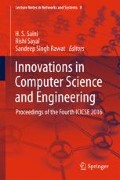Abstract
Nowadays data sources are producing huge amount of data everywhere namely news data, wikis, web crawlers and many other databases, data needs to be analyze and exploited to obtain the required information to build several knowledge databases. In this context time is an essential component of information space and it is a real phenomenon which makes a continuous change through which we live. The information which is associated with time is termed as temporal information and the process of identifying and retrieving times are called as temporal information extraction (TIE). The temporal information extraction is useful in many natural language processing (NLP) applications like information extraction for generating better text summaries and temporal question answering (Q.A) systems for time related searches, and information retrievals etc. Times are also useful to order the events in the text, the ordering can be from the past through the present into the future and this will helpful to measure the durations of an event occurrence and find outs the relation between them. In this paper we present our work for extraction of various forms of times from natural language by using pattern rules. The results obtained from the experiments found to have better precision value when compared with existing methods.
Access this chapter
Tax calculation will be finalised at checkout
Purchases are for personal use only
References
Roser Sauri, Robert Knippen, Marc Verhagen, and James Pustejovsky. Evita: a robust event recognizer for QA systems. In HLT ’05: Proceedings of the conference on Human Language Technology and Empirical Methods in Natural Language Processing, pages 700–707, Morristown, NJ, USA, 2005.
SunghwanSohn, Kavishwar B Wagholikar, Dingcheng Li, Siddhartha R Jonnalagadda, Cui Tao, Ravikumar Komandur Elayavilli, and Hongfang Liu. Comprehensive temporal information detection from clinical text: medical events, time, and tlink identification. Journal of the American Medical Informatics Association, pages amiajnl-2013.
Yan Xu, Yining Wang, Tianren Liu, Junichi Tsujii, I Eric, and Chao Chang. An end-to-end system to identify temporal relation in discharge summaries: 2012.
Schilder, F., and Habel, C. From temporal expressions to temporal information: Semantic tagging of news messages. In Proceedings of the ACL-2001.
Verhagen, M.; Mani, I.; Saur´ı, R.; Knippen, R.; Littman, J.; and Pustejovsky, J. Automating Temporal Annotation with TARSQI-2005.
Allen, J. Maintaining knowledge about temporal intervals. C. ACM 26(11):832–843, 1983.
Matthew Richardson and Pedro Domingos. Markov logic networks. Machine Learning, 2006.
Vanitha Guda, Suresh Kumar Sanampudi.: Rule based Event Extraction in Natural Language Text, In Proceedings of IEEE international conference of Recent Trends in ISBN 978-1-5090-0773-5/16/$31.00 © 2016 IEEE, pp. 47–51, May 2016.
N. Chambers, S. Wang, and D. Jurafsky. Classifying temporal relations between events. Proceedings of the ACL 2007.
B. Boguraev and R. K. Ando. Time Bank-Driven TimeML analysis. In Annotating, Extracting and Reasoning about Time and Events, Dagstuhl Seminar Proceedings. Dagstuhl, Germany, 2005.
Pustejovsky, J., Castano, J., Ingria, R. Saur´ı, R., Gaizauskas, R., Setzer, A., Katz, G., and Radev, D., TimeML: Robust specification of event and temporal expressions in text. In IWCS-5 Fifth Intl. Workshop on Computational Semantics-2003.
Angel X Chang and Christopher D Manning. Sutime: A library for recognizing and normalizing time expressions. In LREC, pages 3735–3740, 2012.
Verhagen, M.; Mani, I.; Saur´ı, R.; Knippen, R.; Littman, J.; and Pustejovsky, J., Automating Temporal Annotation with TARSQI. In Demo Session. Proceedings of ACL, 2005.
Bramsen, P.; Deshpande, P.; Lee, Y.; and Barzilay, R. Inducing temporal graphs. In Procs. of EMNLP, 189–198, 2006.
Mani, I.; Schiffman, B.; and Zhang, J. Inferring temporal ordering of events in news. In Procs. of HLT-NAACL, 2003.
JannikStrotgen and Michael Gertz. Heideltime: High quality rule-based extraction and normalization of temporal expressions. In Proceedings of the 5th International Workshop on Semantic Evaluation, pages 321–324. Association for Computational Linguistics, 2010.
Daniel M. Bikel, Richard Schwartz, and Ralph M. Weischedel. An algorithm that learns what is I in a name. Mach. Learn., 34(1–3):211–231, ISSN0885-6125. 10.1023/A:1007558221122, feb 1999.
J. Poveda, M. Surdeanu and J. Turmo. A Comparison of Statistical and Rule-Induction Learners for Automatic Tagging of Time Expressions in English. In Proceedings of the International Symposium on Temporal Representation and Reasoning, 2007.
Corinna Cortes and Vladimir Vapnik. Support-vector networks. In Machine Learning, pages 273–297, 1995.
Author information
Authors and Affiliations
Corresponding author
Editor information
Editors and Affiliations
Rights and permissions
Copyright information
© 2017 Springer Nature Singapore Pte Ltd.
About this paper
Cite this paper
Guda, V., Sanampudi, S.K. (2017). Pattern Based Extraction of Times from Natural Language Text. In: Saini, H., Sayal, R., Rawat, S. (eds) Innovations in Computer Science and Engineering. Lecture Notes in Networks and Systems, vol 8. Springer, Singapore. https://doi.org/10.1007/978-981-10-3818-1_6
Download citation
DOI: https://doi.org/10.1007/978-981-10-3818-1_6
Published:
Publisher Name: Springer, Singapore
Print ISBN: 978-981-10-3817-4
Online ISBN: 978-981-10-3818-1
eBook Packages: EngineeringEngineering (R0)

